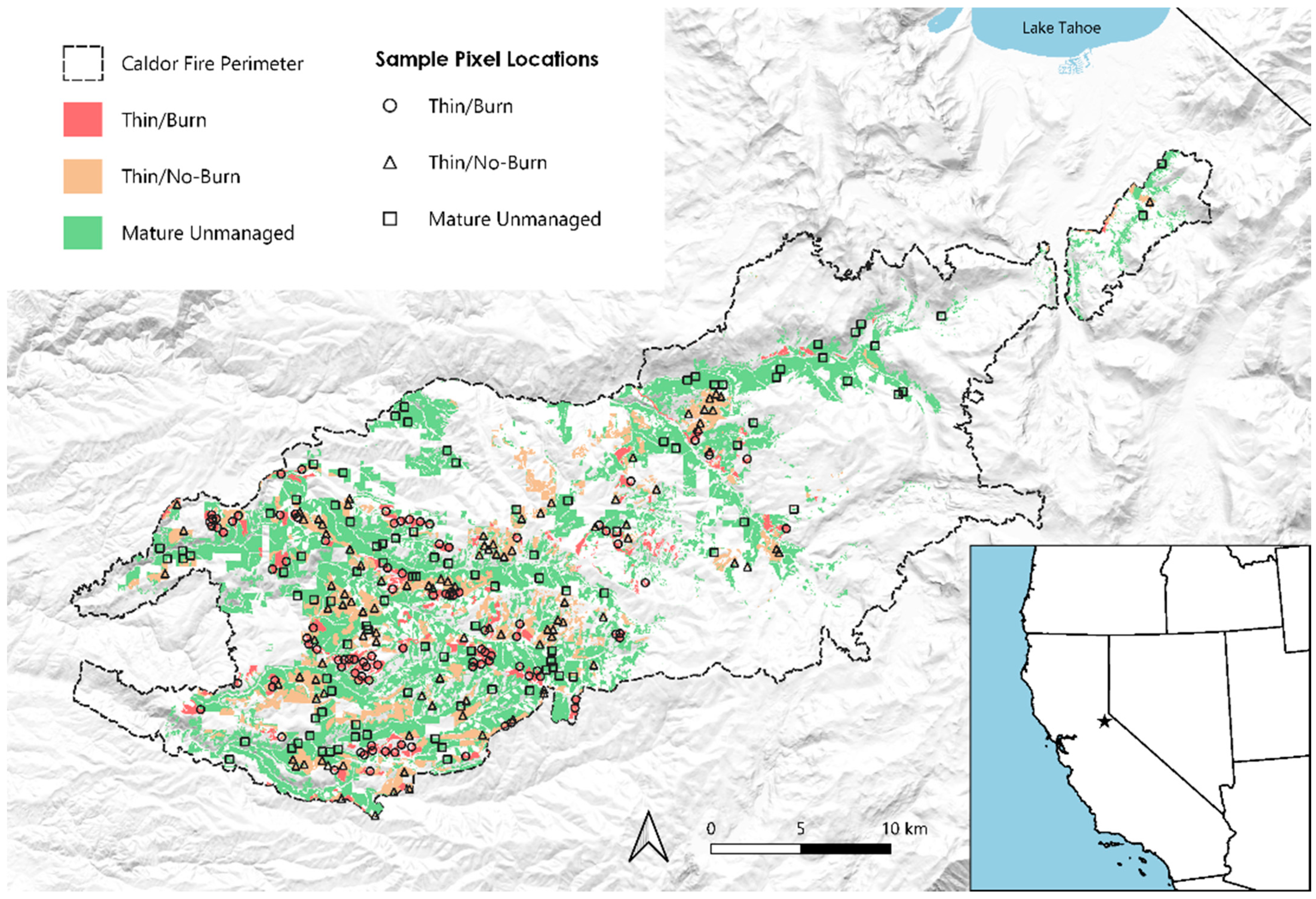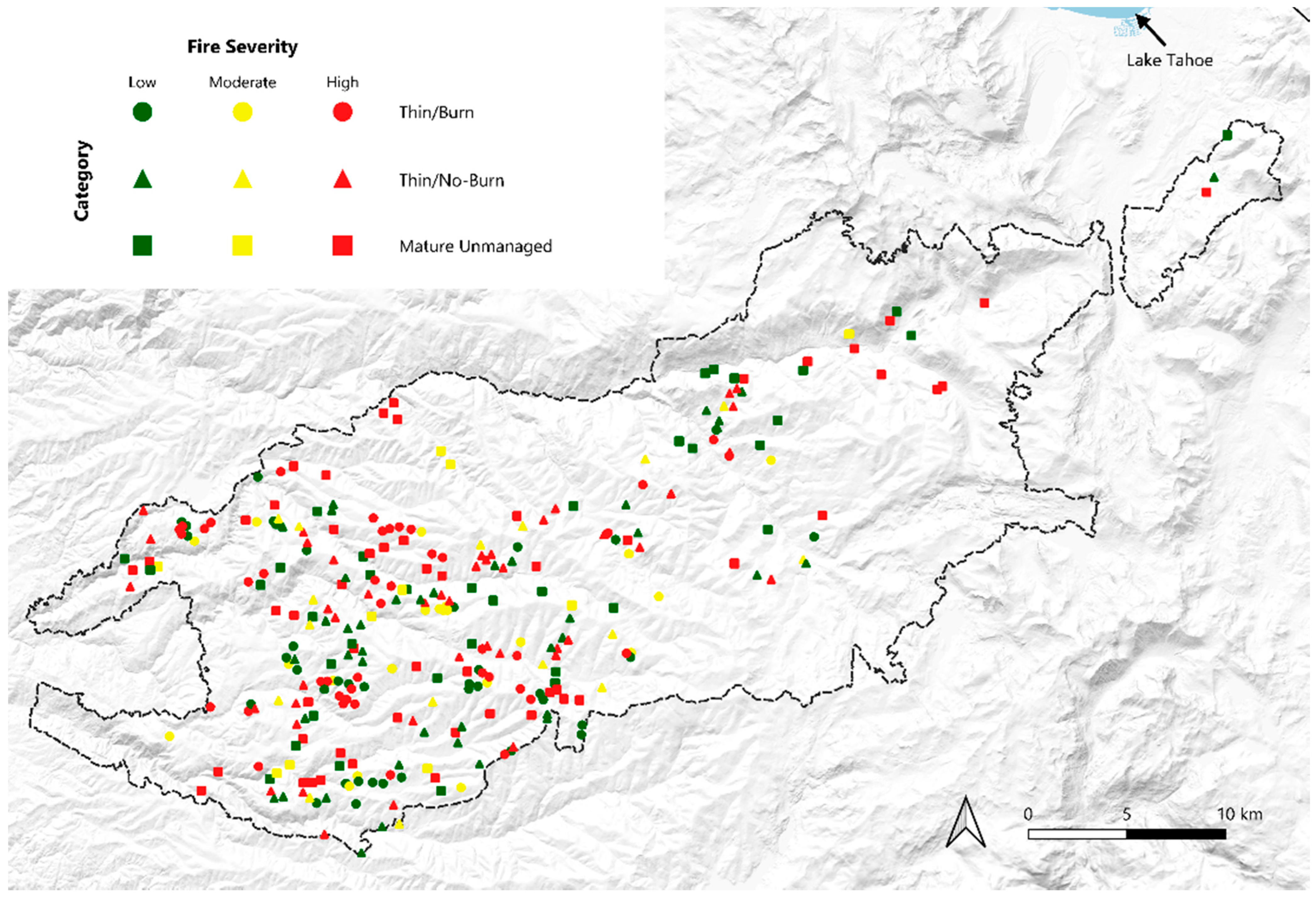Cumulative Tree Mortality from Commercial Thinning and a Large Wildfire in the Sierra Nevada, California
Abstract
:1. Introduction
2. Materials and Methods
3. Results
4. Discussion
5. Conclusions
Supplementary Materials
Author Contributions
Funding
Data Availability Statement
Acknowledgments
Conflicts of Interest
References
- Odion, D.C.; Hanson, C.T.; Baker, W.L.; DellaSala, D.A.; Williams, M.A. Areas of agreement and disagreement regarding ponderosa pine and mixed conifer forest fire regimes: A dialogue with Stevens et al. PLoS ONE 2016, 11, e0154579. [Google Scholar] [CrossRef] [PubMed] [Green Version]
- Baker, W.L.; Hanson, C.T.; Williams, M.A. Improving the use of early timber inventories in reconstructing historical dry forests and fire in the western United States: Reply. Ecosphere 2018, 9, e02325. [Google Scholar] [CrossRef]
- Hessburg, P.F.; Prichard, S.J.; Hagmann, R.K.; Povak, N.A.; Lake, F.K. Wildfire and climate change adaptation of western North American forests: A case for intentional management. Ecol. Appl. 2021, 31, e02432. [Google Scholar] [CrossRef] [PubMed]
- Prichard, S.J.; Hessburg, P.F.; Hagmann, R.K.; Povak, N.A.; Dobrowski, S.Z.; Hurteau, M.D.; Kane, V.R.; Keane, R.E.; Kobziar, L.N.; Kolden, C.A.; et al. Adapting western North American forests to climate change and wildfires: 10 common questions. Ecol. Appl. 2021, 31, e02433. [Google Scholar] [CrossRef] [PubMed]
- North, M.P.; Tompkins, R.E.; Bernal, A.A.; Collins, B.M.; Stephens, S.L.; York, R.A. Operational resilience in western US frequent-fire forests. For. Ecol. Manag. 2022, 507, 120004. [Google Scholar] [CrossRef]
- Romme, W. Fire history terminology: Report of the ad hoc committee. In Proceedings of the Fire History Workshop, Tuscon, AZ, USA, 20–24 October 1980; General Technical Report RM-GTR-81. Stokes, M.A., Dieterich, J.H., Eds.; US Department of Agriculture, Forest Service, Rocky Mountain Forest and Range Experiment Station: Ft. Collins, CO, USA, 1980; pp. 135–137. [Google Scholar]
- Miller, J.D.; Thode, A.E. Quantifying burn severity in a heterogeneous landscape with a relative version of the delta normalized burn ratio (DNBR). Remote Sens. Environ. 2007, 109, 66–80. [Google Scholar] [CrossRef]
- Hanson, C.T. Cumulative severity of thinned and unthinned forests in a large California wildfire. Land 2022, 11, 373. [Google Scholar] [CrossRef]
- Verner, J.; McKelvey, K.S.; Noon, B.R.; Gutierrez, R.J.; Gould, G.I., Jr.; Beck, T.W. The California Spotted Owl: A Technical Assessment of Its Current Status; U.S. Department of Agriculture, Forest Service, Pacific Southwest Research Station: Albany, CA, USA, 1992; p. PSW-GTR-133. [Google Scholar]
- Purcell, K.L.; Mazzoni, A.K.; Mori, S.R.; Boroski, B.B. Resting structures and resting habitat of fishers in the southern Sierra Nevada, California. For. Ecol. Manag. 2009, 258, 2696–2706. [Google Scholar] [CrossRef]
- Zhao, F.; Sweitzer, R.A.; Guo, Q.; Kelly, M. Characterizing habitats associated with fisher den structures in the southern Sierra Nevada, California using discrete return Lidar. For. Ecol. Manag. 2012, 280, 112–119. [Google Scholar] [CrossRef]
- Campbell, J.; Donato, D.; Azuma, D.; Law, B. Pyrogenic carbon emission from a large wildfire in Oregon, United States. J. Geophys. Res. 2007, 112, G04014. [Google Scholar] [CrossRef] [Green Version]
- Campbell, J.L.; Swanson, M.E.; Mitchell, S.R. Can fuel-reduction treatments really increase forest carbon storage in the western US by reducing future fire emissions? Front. Ecol. Environ. 2012, 10, 83–90. [Google Scholar] [CrossRef]
- Harmon, M.E.; Hanson, C.T.; DellaSala, D.A. Combustion of aboveground wood from live trees in megafires, CA, USA. Forests 2022, 13, 391. [Google Scholar] [CrossRef]
- Mildrexler, D.J.; Berner, L.T.; Law, B.E.; Birdsey, R.A.; Moomaw, W.R. Large trees dominate carbon storage in forests east of the Cascade Crest in the United States Pacific Northwest. Front. For. Glob. Change 2020, 3, 594274. [Google Scholar] [CrossRef]
- Hanson, C.T. Is “fuel reduction” justified as fire management in spotted owl habitat? Birds 2021, 2, 395–403. [Google Scholar] [CrossRef]
- U.S. Forest Service—Eldorado National Forest. Raintree Forest Health Project: Environmental Assessment; U.S. Forest Service—Eldorado National Forest: Placerville, CA, USA, 2011. [Google Scholar]
- U.S. Forest Service—Eldorado National Forest. Twofer Fuels Reduction Project; Silviculture Report; U.S. Forest Service—Eldorado National Forest: Placerville, CA, USA, 2019. [Google Scholar]
- U.S. Forest Service—Eldorado National Forest. Trestle Forest Health Project; Silvicultural Report; U.S. Forest Service—Eldorado National Forest: Placerville, CA, USA, 2014. [Google Scholar]
- U.S. Forest Service—Eldorado National Forest. Callecat Ecological Restoration Project; Silviculture Report; U.S. Forest Service—Eldorado National Forest: Placerville, CA, USA, 2013. [Google Scholar]
- Zar, J.H. Biostatistical Analysis, 5th ed.; Prentice-Hall/Pearson: Upper Saddle River, NJ, USA, 2010; ISBN 978-0-321-65686-5. [Google Scholar]
- Stephens, S.L.; Battaglia, M.A.; Churchhill, D.J.; Collins, B.M.; Coppoletta, M.; Hoffman, C.M.; Lydersen, J.M.; North, M.P.; Parsons, R.A.; Ritter, S.M.; et al. Forest restoration and fuels reduction: Convergent or divergent? BioScience 2021, 71, 85–101. [Google Scholar] [CrossRef]
- Jones, G.M.; Keyser, A.R.; Westerling, A.L.; Baldwin, W.J.; Keane, J.J.; Sawyer, S.C.; Clare, J.D.J.; Gutiérrez, R.J.; Peery, M.Z. Forest restoration limits megafires and supports species conservation under climate change. Front. Ecol. Environ. 2022, 20, 2010–2016. [Google Scholar] [CrossRef]
- Keenan, R.J.; Weston, C.J.; Volkova, L. Potential for forest thinning to reduce risk and increase resilience to wildfire in Australian temperate Eucalyptus forests. Curr. Opin. Environ. Sci. Health 2021, 23, 100280. [Google Scholar] [CrossRef]
- Weston, C.J.; Di Stefano, J.; Hislop, S.; Volkova, L. Effect of recent fuel treatments on wildfire severity in Southeast Australian Eucalyptus sieberi forests. For. Ecol. Manag. 2022, 505, 119924. [Google Scholar] [CrossRef]
- Bartowitz, K.J.; Walsh, E.S.; Stenzel, J.E.; Kolden, C.A.; Hudiberg, T.W. Forest carbon emission sources are not equal: Putting fire, harvest, and fossil fuel emissions in context. Front. For. Glob. Change 2022, 5, 867112. [Google Scholar] [CrossRef]
- Bradley, C.M.; Hanson, C.T.; DellaSala, D.A. Does increased forest protection correspond to higher fire severity in frequent-fire forests of the western USA? Ecosphere 2016, 7, e01492. [Google Scholar] [CrossRef]
- Raposo, M.A.M.; Pinto Gomes, C.J.; Nunes, L.J.R. Selective shrub management to preserve Mediterranean forests and reduce the risk of fire: The case of mainland Portugal. Fire 2020, 3, 65. [Google Scholar] [CrossRef]
- Taylor, C.; Blanchard, W.; Lindenmayer, D.B. Does forest thinning reduce fire severity in Australian eucalypt forests? Conserv. Lett. 2021, 14, e12766. [Google Scholar] [CrossRef]
- Taylor, C.; Blanchard, W.; Lindenmayer, D.B. What are the associations between thinning and fire severity? Austral Ecol. 2021, 46, 1425–1439. [Google Scholar] [CrossRef]
- Hutto, R.L. The ecological importance of severe wildfires: Some like it hot. Ecol. Appl. 2008, 18, 1827–1834. [Google Scholar] [CrossRef] [PubMed]
- DellaSala, D.A.; Bond, M.L.; Hanson, C.T.; Hutto, R.L.; Odion, D.C. Complex early seral forests of the Sierra Nevada: What are they and how can they be managed for ecological integrity? Nat. Areas J. 2014, 34, 310–324. [Google Scholar] [CrossRef] [Green Version]
- DellaSala, D.A.; Baker, B.C.; Hanson, C.T.; Ruediger, L.; Baker, W.L. Have western USA fire suppression and megafire active management approaches become a contemporary Sisyphus? Biol. Conserv. 2022, 268, 109499. [Google Scholar] [CrossRef]
- Safford, H.D.; Stevens, J.T.; Merriam, K.; Meyer, M.D.; Latimer, A.M. Fuel treatment effectiveness in California yellow pine and mixed conifer forests. For. Ecol. Manag. 2012, 274, 17–28. [Google Scholar] [CrossRef]
- Prichard, S.J.; Povak, N.A.; Kennedy, M.C.; Peterson, D.W. Fuel treatment effectiveness in the context of landform, vegetation, and large, wind-driven wildfires. Ecol. Appl. 2020, 30, e02104. [Google Scholar] [CrossRef]
- Lydersen, J.M.; Collins, B.M.; Brooks, M.L.; Matchett, J.R.; Shive, K.L.; Povak, N.A.; Kane, V.R.; Smith, D.F. Evidence of fuels management and fire weather influencing fire severity in an extreme fire event. Ecol. Appl. 2017, 27, 2013–2030. [Google Scholar] [CrossRef]
- Stephens, S.L.; Moghaddas, J.J.; Edminster, C.; Fiedler, C.E.; Haase, S.; Harrington, M.; Keeley, J.E.; Knapp, E.E.; McIver, J.D.; Metlen, K.; et al. Fire treatment effects on vegetation structure, fuels, and potential fire severity in western U.S. Forests. Ecol. Appl. 2009, 19, 305–320. [Google Scholar] [CrossRef] [Green Version]
- Cruz, M.G.; Alexander, M.E. Assessing crown fire potential in coniferous forests of western North America: A critique of current approaches and recent simulation studies. Int. J. Wildland Fire 2010, 19, 377. [Google Scholar] [CrossRef]
- Cruz, M.G.; Alexander, M.E.; Dam, J.E. Using modeled surface and crown fire behavior characteristics to evaluate fuel treatment effectiveness: A caution. For. Sci. 2014, 60, 1000–1004. [Google Scholar] [CrossRef]


| Severity Measurement | Mature Unmanaged | Thin/Burn | Thin/No-Burn |
|---|---|---|---|
| Fire Severity Only | 56.0 (35.3) | 52.0 (33.5) | 51.0 (34.5) |
| Cumulative Severity | 56.0 (35.3) | 64.8 (24.5) | 64.0 (25.3) |
Publisher’s Note: MDPI stays neutral with regard to jurisdictional claims in published maps and institutional affiliations. |
© 2022 by the authors. Licensee MDPI, Basel, Switzerland. This article is an open access article distributed under the terms and conditions of the Creative Commons Attribution (CC BY) license (https://creativecommons.org/licenses/by/4.0/).
Share and Cite
Baker, B.C.; Hanson, C.T. Cumulative Tree Mortality from Commercial Thinning and a Large Wildfire in the Sierra Nevada, California. Land 2022, 11, 995. https://doi.org/10.3390/land11070995
Baker BC, Hanson CT. Cumulative Tree Mortality from Commercial Thinning and a Large Wildfire in the Sierra Nevada, California. Land. 2022; 11(7):995. https://doi.org/10.3390/land11070995
Chicago/Turabian StyleBaker, Bryant C., and Chad T. Hanson. 2022. "Cumulative Tree Mortality from Commercial Thinning and a Large Wildfire in the Sierra Nevada, California" Land 11, no. 7: 995. https://doi.org/10.3390/land11070995
APA StyleBaker, B. C., & Hanson, C. T. (2022). Cumulative Tree Mortality from Commercial Thinning and a Large Wildfire in the Sierra Nevada, California. Land, 11(7), 995. https://doi.org/10.3390/land11070995







